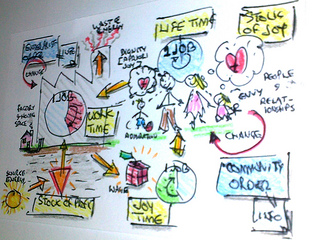Quality of Life: Can the Mentally Ill Obtain It?

by Amber Maccione
Between the 1940s and the 1960s, the United States has made efforts to give the mentally ill the opportunity to have quality of life outside the walls of a mental hospital (Curtis, 2008 & Martin, 2014). With the introduction of new medications, new methods to administer these medications, and the construction of outpatient facilities, the mentally ill were able to be deinstitutionalized and enter into society at the chance to be a part of the mainstream (Curtis, 2008). The ideology behind this was that it was inhuman to lock up the mentally ill when knowledge had created the ability to give them their freedom and independence (Curtis, 2008). Although some feel that the release of the mentally ill into society has increased their liberty and brought positive change, others feel that it has only brought negativity as the mentally ill do not know how to live in mainstream society causing homelessness and crime (Curtis, 2008). Therefore, the concern for today is whether or not the mentally ill can fit into the mainstream society and have a chance at obtaining quality of life or if society as a whole will make it impossible for them to do so (Curtis, 2008).
Deinstitutionalization of Mentally Ill
Although laws began to be put in place in the late 1940s that benefitted the mental health field and the mentally ill, it wasn’t really until the 1960s that the laws gave support to both so that the mentally ill could obtain quality of life through the funding of their basic needs (Aid to the Disabled Act) and receive resources from community mental health centers in their area (Mental Retardation Facilities and Community Mental Health Centers Construction Act) (Curtis, 2008). Along with these acts also came new medications and new methods of administering the medications (Curtis, 2008). Since there was no need to keep the mentally ill confined because of these new developments, it meant that patients inside the mental hospitals could be released into mainstream society. This was called deinstitutionalizing patients (Curtis, 2008). Deinstitutionalizing not only meant that outpatient facilities needed to be available, but also that emergency responders needed to be ready (Curtis, 2008). For some, deinstitutionalization brought an increase of freedom to the mentally ill, which provided them the opportunity having quality of life (Curtis, 2008). For others, deinstitutionalization brought homelessness and crime to society causing the mentally ill to go from mental hospitals into prisons (Curtis, 2008).
Should the mentally ill be deinstitutionalized?
Positives & Negatives of Deinstitutionalization
As stated, deinstitutionalization brought a measure of liberty to the mentally ill (Curtis, 2008). They were no longer trapped behind walls and the automatic locked doors of their rooms. They were able to come and go as they pleased. They could have a job and make money (Curtis, 2008). They could enjoy life’s amenities such as walks in the park, going shopping or dancing, and even going to see a movie (Curtis, 2008). They were also able to have a social life and interact with other people besides a medical staff or other mentally ill people (Curtis, 2008). The mentally ill could have a life outside their illness. Being deinstitutionalized gave them a chance of having quality of life.
Others thought that deinstitutionalization was a failure (Curtis, 2008). When the mentally ill could not function in mainstream society, homeless, crime, illness, and injury were just some of the things that followed the mentally ill. Therefore, they did not get a chance at having quality of life because the prisons began to fill with them (Curtis, 2008). Stereotypes, biases, and stigmas arose causing people to have negative opinions about the mentally ill even if they had never socialized with someone having a mental illness (Curtis, 2008). Also, without the proper knowledge and training coupled with the wrong mentality of trying to help the mentally ill, the emergency responders and public hospital personnel did not really know how to help these individuals (Curtis, 2008).

Quality of Life Defined
Therefore, today, the major concerns of the mentally ill are their rights as human beings and how the public eye views them collectively (Curtis, 2008). This boils down to two questions: 1) Do the mentally ill have the right to quality of life? and 2) Can they experience quality of life without the proper care and treatment? The answer to the first question is yes, whereas, the second is no.
Do the mentally ill have the right to quality of life?
The answer to this question is yes. Since the mentally ill are human beings, they have the right to quality of life. Therefore, the question should be what does quality of life mean? According to the World Health Organization (WHO), the quality of life is defined “as individuals’ perception of their position in life in context of the culture and value systems in which they live and in relation to their goals, expectations, standards and concerns” (1997). Yet, how can the quality of life really be defined if it is subjective and multidimensional depending on who the individual is and what their values, expectations, goals, and desires are? (IESE Insights, 2013). Quality of life covers both the positives and negatives of life and depends on how the individual responds to these events (IESE Insights, 2013). According to IESE Insights, quality of life encompasses the individual being satisfied with life; being healthy in physically and psychologically; having a sense of independence, experiencing family, education, wealth, religion, employment, and social relationships; and being able to use local services and transportation (2013). All of these things may look different person from person. Having the opinion of the mentally ill not being able to have quality of life is incorrect since one cannot determine someone else’s quality of life when each person has differences in what he or she values and desires
Can the mentally ill experience quality of life without proper care and treatment?
If the mentally ill can experience quality of life, can they do so without the proper care and treatment of their illness? The answer to that is no. Therefore, the question should be how mainstream society can ensure that the proper care and treatment is available so that the mentally ill can enjoy their right to quality of life. As stated, deinstitutionalization gave patients the ability to be provided for through outpatient facilities and also place emergency responders in society to help them with any issues (Curtis, 2008). Unfortunately, negative attitudes towards the federal government arose because of lack of funds to ensure that the mentally ill received proper care and treatment (Martin, 2014). The burden then fell on the public hospitals, nursing homes, streets, and prison system to take care of the mentally ill (Martin, 2014). Yet, these emergency responders and these avenues lacked the knowledge needed to diagnose and provide adequate care (Curtis, 2008). Therefore, in order for the mentally ill to really experience quality of life, those in the community such as police, firemen, hospitals, and community service centers need to be trained and educated so that they have the skills and knowledge to help the mentally ill within mainstream society (Curtis, 2008).
Rethink Mental Illness
Conclusion
Tommy had Down’s syndrome. He though graduated high school and moved into a group home landing a job in a factory. He enjoyed friendships with his housemates, spent time with family on the weekends, and even went on different outings. He had his own room in the group home, which he took care of, and also was able to use the bus to come and go as he pleased as long as he notified the nurses in the group home about where he was going and when he would be returning. He was able to enjoy quality of life with the help of others who made sure he got the adequate care and treatment through the group home setting. This is what deinstitutionalization was meant to look like. Tommy wouldn’t have been able to have quality of life if the community had not taken responsibility of ensuring he had adequate care. With deinstitutionalization, the quality of life for the mentally ill becomes a community responsibility. The negativity towards these individuals and the federal government does not help, but instead hinders the mentally ill from being able to experience quality of life. Therefore, the community needs to become educated and learn to understand and accept the mentally ill as part of mainstream society (Curtis, 2008). Just as Tommy’s group home helped him and allowed him to have quality of life, the rest of the United States, within communities, needs to do the same for others like Tommy.
Curtis, T.S. (2008, May 1). Unstable situation. Fire Chief, 52(5), 30-34. (ProQuest Document ID: 1487610591).
IESE Insight. (2013, September 4). “Quality of Life: Everyone Wants It, But What Is It?” Forbes.com. Retrieved from www.forbes.com/sites/iese/2013/09/04/quality-of-life-everyone-wants-it-but-what-is-it
Martin, M.E. (2014). Introduction to human services: Through the eyes of practice settings (3rd ed.). Boston, MA: Pearson Education.
World Health Organization. (1997). “WHOQOL: Measuring Quality of Life.” Division of Mental Health and Prevention of Substance Abuse. Retrieved from www.who.int/mental_health/media/68.pdf
Copyright © 2014 http://ambercita04.hubpages.com/ All Rights Reserved
© 2014 Amber








